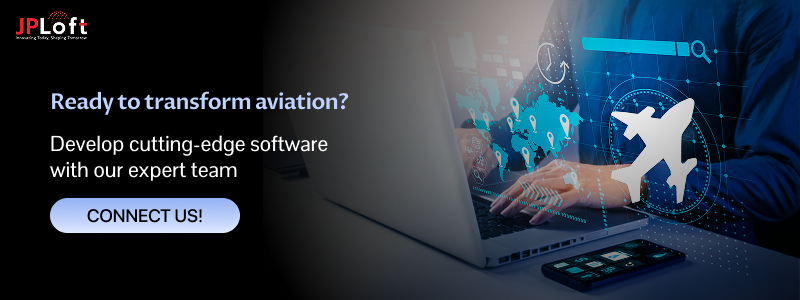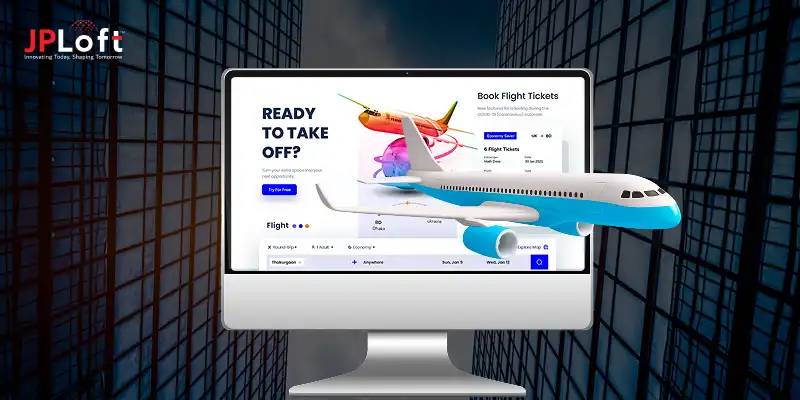Are you an entrepreneur looking to enter the aviation industry?
Then, building aviation software is what you need to look for.
Well, in this competitive industry, one of the attributes that might be impactful is “how to proceed with aviation software development?” to lead.
All you need is the right process that begins from market research and ends on launch.
Now, the question is “What does the software look like?”
“In aviation, the margin for error is zero. Software must be perfect, not just good enough.
With this quote, you should note that software must be effective and simple for users to book flights, resulting in a smooth process from entering the airport to departure and then exit.
In this guide to aviation software development, we will explore all the steps, features, types, roles, and costs.
Let’s proceed further.
Key Takeaways:
Aviation software development is crucial for enhancing safety, efficiency, and overall operations in the industry.
The global aviation software market is growing rapidly and is expected to reach USD 11.68 billion by 2032, offering significant investment opportunities.
Developing aviation software helps streamline operations, optimize costs, and improve customer experiences.
Follow a structured development process, including market research, requirements analysis, MVP creation, and rigorous testing, to build effective aviation software.
Different types of aviation software exist, including avionics, airline operations, and MRO solutions, each serving vital functions.
Adhere to safety standards like DO-178C for robust and compliant aviation software.
JPLoft, a company known for developing aviation software, can help you convert your dream idea into reality in simple steps.
What is Aviation Software?
Before we switch to the next steps, let’s learn a bit about aviation software.
Aviation software can be considered as an umbrella of digital solutions that are designed to meet the diversified requirements of the users.
Under this, you can find everything from intricately embedded systems to large-scale enterprise applications that are controlled by airlines, airports, and even the air traffic control systems.
This software uses a wide range of digital tools that are critically used for managing and optimizing different aspects of the aviation industry, beginning from flight operations to passenger services, and maintenance operations.
Such software solutions are very important for enhancing safety, efficiency, and overall operations. This software helps to improve the performance of the industry.
Now, let’s consider the following section for the stats.
Aviation Software and Related Stats
How to develop aviation software?
You should evaluate the current market and related stats before answering the steps to create aviation software.
Hence, let’s proceed.
The current stats can help you to understand the industry and market size. You can explore the stats and should adopt the same in your app to increase your brand’s presence in the market.
Here’s all about the aviation software market.
-
The global aviation software market size was estimated at USD 10.68 billion in 2023 and is expected to grow at a CAGR of 7.2% from the year 2024 to 2030.
-
Additionally, the MRO software market size was valued at USD 7.70 billion in 2024. This market is predicted to grow from USD 8.13 billion in 2025 to USD 11.68 billion by 2032, exhibiting a CAGR of 5.3% during the forecasted period.
-
This market size is calculated at USD 11.50 billion in 2024, which is predicted to reach USD 23.10 billion by 2034, expanding at a CAGR of 7.23% from 2024 to 2034.
-
When it comes to the US region, the aviation MRO software market size is estimated at USD 3.37 billion in 2025 and is further expected to reach USD 4.18 billion by 2030.
-
The aviation market is valued at approximately USD 7.5 billion in 2024 and is anticipated to reach USD 14.9 billion by 2033, reflecting a CAGR of 8.1% from 2025 to 2033.
After considering these stats, you might get an idea of why to go for aviation software development in 2025.
If you are still confused about why develop aviation software, then considering the reasons behind it can help.
Let’s learn about them below.
Why Create Aviation Software?
Struggling to find “how to make aviation software?”
Well, before ‘how” you should question “why”.
The aviation software is developed to enhance different aspects of the aviation industry, including safety, efficiency, and customer experience.
Here is a list of reasons to consider while developing aviation software.
A] Growing Market Size
With the growing market size of the aviation sector, expected to grow from USD 8.13 billion in 2025 to USD 11.68 billion by 2032, it is creating a new opportunity to invest in it.
You can create aviation software after evaluating the present market conditions. It is further helpful in enhancing operational efficiency, optimizing the routes, as well as streamlining the procedures.
B] Enhance Safety
Building aviation software can be helpful in automation and for building the complex algorithms used by businesses for streamlining safety procedures.
Here, you can implement advanced data analysis, and safety management systems that lead to continuous improvement of the businesses. Hence, building the software can help you ensure trust among the users.
C] Helps to Streamline Operations
When you proceed to build the aviation software, it will enable the software to automate tasks such as flight planning, crew scheduling, and maintenance scheduling, reducing the manual workload, as well as minimizing human error.
You should analyze data, where software can assist airlines in optimizing the use of resources such as fuel and crew and minimizing wastage.
D] Optimized Costs
When you proceed to build aviation software, it will help you to optimize the complete costs, through optimizing the fuel consumption, optimizing the flight paths, reducing fuel costs, and minimizing fuel consumption.
It further helps businesses in predictive maintenance, with better resource management, which ultimately leads to lower expenses and better productivity.
E] Fosters Customer Experiences
By investing in aviation software development, you can improve overall customer experiences by providing personalized services, improving baggage timing, and streamlining the check-in and boarding process.
It can help in leveraging data analytics, AI, and automation, through which airlines can offer tailored recommendations, and real-time support, which further leads to increased user satisfaction and loyalty.
You can hire dedicated developers to know more about your project and its requirements in this competitive environment.
Now, as you are ready to make aviation software, let’s get ahead to learn about the role of custom aviation software in improving airline efficiency in the next section.
Role of Custom Aviation Software to Enhance Airline Efficiency
Custom aviation software does play a critical role in streamlining operations, optimizing resource allocation, as well as to make strategic decisions.
Let’s explore the role of custom aviation software in this section.
► Improves Core Operations
Through Aviation software, you can improve the efficiency of airlines, resulting in improved efficiency, safety, and even accuracy via automation, data-driven insights, and predictive evaluation.
► Enhances Customer Experience
With the help of custom aviation software, you can add personalization while booking experiences, tailor offers, and improve communication.
You can boost satisfaction by implementing customized software and enabling real-time passenger notification.
► Data Analytics and Business Intelligence
Through custom software development, you can continue analyzing the user’s data. It helps users to organize, manage, and even evaluate the data efficiently. With the help of aviation software, companies can track inefficiencies, track key performance, etc.
► Helps to Set Dynamic Pricing and Revenue Management
Sophisticated revenue management systems can be tailored towards an airline’s specific route network, further creating personalized bundles. This helps you in managing the revenue systems, effectively.
► Crew Management and Scheduling
Crew management and scheduling represent one of the most complex and intuitive software solutions that enable aviation organizations to optimize crew operations effectively. It is one of the important aviation software roles to consider.
Now, after evaluating the role, let’s learn about the diversified types of aviation software that you can build in the following section.
Different Types of Aviation Software to Build
When you enter the aviation industry, it's important to know the type of software that you can develop.
Learning about the types can help identify the core type of software that you should proceed with.
Let’s learn it all in this section.
1. Avionics Software
It is an embedded software developed for use in aircraft and spacecraft, focusing on safety-critical systems.
The purpose of this system is a safety-critical type that is directly integrated into the aircraft hardware.
2. Airline Operations Software
Airline operations software aims to optimize an airline’s day-to-day activities, from flight planning and scheduling to crew management and maintenance.
This software acts as a central platform for managing all the different aspects of the airline.
3. Airport Management Software
Airport management software can be used for managing airport operations, including aircraft parking, fuel orders, ground handling services, along gate assignments. It is a specialized platform that automates operations and helps to integrate tools for systematic planning.
4. Fleet Management Software
Fleet management software is a system that will be helpful to businesses for managing their vehicles as well as related operations from acquisition to disposal. It does provide a solution to businesses to track the vehicle and park it, and is even helpful for scheduling maintenance.
5. Traffic Management Software
Traffic management software is a type that uses diversified technologies, including sensors and communication networks, and analyzes the plane's data. Additionally, it typically uses the technology for monitoring, analyzing, and even controlling traffic signals.
6. MRO Software
MRO (Maintenance, Repair, and Overhaul) is a software strategy that helps to address the ongoing service requirements of the aviation industry. Here, the key functions of aviation software can be inventory management, order management, scheduling, planning, etc.
After considering different types of aviation software, let’s learn the features to include in aviation software, below.
Features to Include in Aviation Software
Learning about the features to include in aviation software can help identify and build elements preferred by target users.
Here is a list of features to consider when it comes to making aviation software.
► Flight Planning and Optimization
This feature in aviation software can be useful in route planning, navigation, and weather integration. It further helps aviation businesses to optimize the routes and improve aircraft performance for determining fuel-efficient routes.
► Real-Time Tracking
You should adopt a real-time tracking feature while building aviation software, which will allow you to continuously monitor the aircraft’s location, performance, and other vital parameters during flight operations.
► Inventory & Materials Management
With the help of the inventory and materials management feature, businesses can focus on managing aircraft parts, supplies, and even inventory levels to ensure efficient maintenance operations as well as minimize downtime.
► Crew Management
You should include the feature of crew management in the aviation software, where you can roster, efficiently assign pilots, link to the cabin crew and ground staff while adhering to strict duty regulations, absence management, and even be helpful in compliance tracking.
► Airline Reservation & Ticketing
With the airline reservation & ticketing feature, you can proceed with allowing the passenger to search, book, and purchase flight tickets. Additionally, with this feature, you can store and manage the complete passenger information. This feature can also help with check-in & boarding.
► Push Notifications
You should implement the features of push notification, helping the users to get real-time updates related to any changes in flight scheduling, bookings, cancellations, etc. It is one of the significant features helping users to get information related to current updates.
► Payment Gateway Integration
Integrating a secure payment gateway in aviation software can assist users in booking flights by going through a secure payment procedure. It does include connecting a merchant’s website or application to the payment processor, which enables online transactions to be processed securely.
► Social Media Sharing
It's important to include the feature of social media sharing, where users can share their flight bookings with friends, relatives, and others through diversified platforms such as Instagram and many others.
Considering these features, you can continue building the aviation software.
Let’s consider all the steps below.
How to Build Aviation Software?
Building aviation software comprises a structured process focused on reliability, safety, along regulatory practices.
It does include requirements analysis, system architecture design, prototyping, development, and much more.
Let’s learn more about the steps in this section.
Step 1: Market Study and Research
Do you know what’s happening in the current environment?
Well, evaluating the current market needs, understanding the requirements of the target users, and learning about what competitors are doing should be evaluated and considered.
Here, you can set the SMART objectives for your project and evaluate whether the project purpose serves the gap that exists in the environment.
You can create a complete blueprint of the project here, helping to achieve the determined goals.
Step 2: Evaluate the Requirement
Are you aware of what your aviation software requires?
Well, it is important to look ahead to the project needs along with the types of resources to include while building the software.
Additionally, it's important to focus on defining, categorizing, and prioritizing all the stages of development. Before planning the plots, it's important to identify the stakeholders, define the project goals, and even evaluate the documentation needs.
Step 3: Build an MVP
Confused about what an MVP is?
Well, it's all about the version of the project where you can ask the early investors to fund the project after launching it with minimal features. Here, all you need is to build a version of the software application with adequate features to attract early investors.
The MVP version of the project can help you to know and evaluate the current demands of the audience in this competitive market. Along with this, you can validate whether your idea is impactful in the market or not.
Step 4: Select the Engaging Features
Do you want to add engaging features to the aviation software?
Well, features act as the blood in the software and connect you to the audience. Here, features such as flight search, booking, scheduling, managing flights, boarding processes, customer profile management, payment processing, and integration with the GDS can be included.
Selecting the features for the software will help you frame the infrastructure for your complete project in this competitive market. It will help you to lead the audience and connect with them well.
Step 5: Design the Software
Can UI/UX impact the interaction of your aviation software?
Well, without an engaging design, you cannot proceed with aviation software development. You should focus on the user-centric approach, a thorough market analysis, and iterative development.
If you are thinking of creating an app, then going for the mobile app wireframe and building an app prototype is crucial, which leads to finalizing a blueprint where you can find all the design outlines.
Step 6: Build the Core Functionalities
Are you aware of the core and technical aspects of building the backend of the software?
Whether it's learning about the mobile app tech stack or including core tech stack for aviation software, it is crucial to select top backend technologies, languages, databases, etc, for your customized software.
All you need here is to select the languages, databases, AI/ML integration, cloud services, third-party integrations, and other determinants when it comes to supporting the features of the software with a strong backend procedure.
Step 7: Test the Software
Puzzled about testing the software?
Well, you cannot excel in the industry without robust and rigorous testing. It's important to implement continuous testing protocols while creating aviation software. You should remember that testing a mobile app varies from software testing.
Along with this, implementing the AI or ML tools for testing the software can be one of the crucial aspects to follow. Here you can include performance testing, usability testing, and even the third-party integration software testing smoothly.
Step 8: Launch and Maintain
Ready to launch your aviation software?
Now, it's time to launch the software with the utmost care and confidence. You should launch the software on the defined date as per the project goal to help users book flights, and even for software enhancement.
Regular maintenance can help you to sustain the competition and to follow the user’s feedback. This process will help you to ensure that a software product remains functional, secure, and even relevant across the cycle.
Whether it's about an app or software, a leading mobile app maintenance service can evaluate the frequency and timeline for maintenance.
These were some of the important steps to consider while building aviation software.
Well, when it comes to creating an app related to aviation, connecting with the best mobile app development company can help you to customize these steps as per your project.
Now, let’s learn how you can develop aviation software via artificial intelligence in the proceeding section.
Use of AI to Develop Aviation Software
How to make aviation software with AI?
You should develop AI models beginning with machine learning, deep learning, computer vision, and NLP.
Can you imagine your aviation software without AI, in this competitive market? Well, the answer is a strict “no”.
Artificial intelligence in aviation software not only helps you in selecting the appropriate codes, but it will guide you towards achieving a project aim smoothly.
Let’s learn more here.
► Next-Gen GPS-Less Navigation (AI/ML)
As per Business Wire, the UAE has launched this technology along with secure flight control for strengthening aviation security.
AT IDEX 2025, UAE's ADASI (part of the EDGE group) has launched this technology. Offering resilient and secure flight control.
You can include Perceptron, which is a vision-based system ensuring reliable navigation without GPS.
► Predictive Maintenance (AI/ML)
Airlines are adopting AI for analyzing aircraft sensor data and maintenance records for predicting component failures before they actually happen.
Along with this, the approach can reduce costly unscheduled downtime and optimize parts inventory. You can connect with a leading ML development service in this respect.
The use of predictive maintenance in aviation software can help in utilizing real-time data and advanced analytics for anticipating potential aircraft component failures before they occur.
► Traffic Management (AI/ML)
One of the prime uses of AI is to manage traffic successfully, and it is effective for scheduling flight routes for fuel optimization by minimizing delays and considering real-time air traffic.
Additionally, the AI copilots are developed to assist pilots and air traffic controllers with real-time decision-making, aiming to enhance safety and potentially reduce the required crew.
It does help to enable intelligent systems for optimizing traffic flow, enhancing safety, as well as improving overall efficiency.
Along with this, whether it's about creating an AI app or software, AI can help you improve safety & incident analysis, and can provide critical insights for proactive risk management.
Likewise, through AI-powered chatbots, you can enhance the overall customer experience by leveraging NLP, as well as streaming customer support.
Connecting with a leading AI development company can be helpful.
Till now, we have explored the concept of aviation software, features, types, reasons, and the usage of AI, but the question that might be bothering you is “Cost.”
Well, worry not, it's the right time to discuss it. Let’s look into the next section.
Cost to Create Aviation Software
What’s the cost to make aviation software?
The average cost to build aviation software can range from $15,000 to $80,000, depending on the types and components you want to include in the same.
Let’s discover the breakdown of the cost in the table below.
|
Factor Impacting Cost |
Description |
Impact on Price |
|
Complexity & Features |
Number and intricacy of functionalities (e.g., simple flight tracking vs. advanced data analytics). |
High |
|
UI/UX Design |
The sophistication of user interface and experience (e.g., basic screens vs. intuitive, custom dashboards). |
Medium |
|
Platform (Web/Mobile) |
Development for a single platform (iOS or Android) or a cross-platform web application. |
Medium |
|
Integrations |
Need to connect with third-party systems (e.g., weather APIs, existing databases). |
Medium |
|
Regulatory Compliance |
Meeting specific aviation standards (e.g., less strict for internal tools vs. critical flight ops). |
High |
|
Team Size & Location |
Number of developers, designers, QA, and their hourly rates (e.g., Indian teams vs. Western). |
High |
|
Testing & QA |
Rigor and depth of testing are required to ensure reliability and safety. |
Medium |
|
Security Measures |
Implementation of robust cybersecurity protocols for data protection. |
Medium |
Well, in the case of an app, when it comes to analyzing the mobile app development cost or an AI app development cost, the answer will depend on the factors mentioned in the above table.
Now, let’s look forward to the timeline related to building aviation software in the section below.
How Long Does it Take to Create Aviation Software?
The time to build aviation software can vary from 6 months to 8 months, depending on factors such as complexity, project scope, team size, and experience, along with the requirements and regulations.
Here, factors such as project and scope, regulatory compliances, complexity of integration, team sizes & expertise, testing, along with client responsiveness should be evaluated.
You can check out the table below for more.
|
Phase |
Estimated Timeline (General) |
|
Discovery & Planning |
1-2 months |
|
Design & Development |
3-4 months |
|
Testing & Deployment |
2-3 months |
|
Total Estimated Time |
6 - 8 months |
Now, let’s proceed with the tips to improve your aviation software in the section below.
Practices to Enhance the Development of Aviation Software
When you enter the aviation industry, it's important to engage the target audience, and without opting for effective practices you cannot get ahead of the competitors.
Let’s discover these practices in this section.
► Use Customer-First Approach
Without considering the core customer preferences, you cannot win the market. Hence, it's important to use user feedback while creating aviation software.
Consider what users like to prefer from aviation software, then step out the features, and the development process accordingly.
► Consider an in-depth Market Study.
Are you aware of the aviation market, the competitors, and current technology trends, well it is one of the foremost tips to lead.
You should evaluate the recent updates on industry 4.0 technology, and then implement it. Such as including Gen-Next GPS integration or a predictive maintenance element for enhancing the software’s sustainability.
► Safety- Standard Compliance
Your aviation software should comply with security standard guidelines like DO-178C (Software Considerations in Airborne Systems and Equipment Certification).
This will help you to ensure users’ safety while using the aviation software. Additionally, you can enhance the user’s trust by enabling them to book flights by securely inputting data.
► Continuous Third-party Integration and Testing
In this competitive environment, a regular integration of the third party will make your software trendy and help you boost the overall performance of the software.
Along with this, it is important to conduct rigorous testing. Here, all you need to perform integration tests, functional testing, end-to-end testing, and many others.
► Configuration Management and Traceability
Configuration management is a critical aspect that helps to provide technical and administrative direction while developing aviation software. Hence, add this concept to improve the development procedure.
Along with this, you need to trace every component in developing aviation software. Whether it's from the requirement analysis to implementation and then testing.
Considering these tips can help you build aviation software too, with the appropriate guidance.
Build Your Customized Aviation Software with JPLoft!
Struggling to build aviation software?
Worry not! JPLoft is here to help.
Our team specializes in providing customized solutions based on your growing needs and current market requirements.
The team can help you to include appropriate features and other related minor details based on the required projects that will help you lead.
We are the leading Aviation Software Development Company focused on delivering integrity, quality, and honesty with every aspect of your project. Our team is determined to understand your perspective and then help you to convert it into reality.
Conclusion
Developing aviation software is paramount for enhancing safety, efficiency, and overall operations in a rapidly expanding global market, projected to reach over $23 billion by 2034.
This specialized software, ranging from avionics to MRO and traffic management systems, streamlines crucial processes like flight planning, crew scheduling, and maintenance. Key to its success are practices such as a customer-first approach, stringent safety-standard compliance (like DO-178C), and robust configuration management with full traceability.
Embracing AI for predictive maintenance and next-gen navigation further elevates functionality, ensuring the development of reliable and impactful aviation solutions.
FAQs
Aviation software encompasses digital solutions for the aviation industry, managing everything from embedded aircraft systems to large-scale airline, airport, and air traffic control operations to enhance safety and efficiency.
Investing in aviation software is beneficial due to a growing market, and its ability to enhance safety, streamline operations, optimize costs, and foster improved customer experiences within the industry.
Developing aviation software requires a structured approach following a Software Development Life Cycle (SDLC), emphasizing rigorous requirement analysis, system design, coding, and extensive testing. Due to strict safety regulations (like DO-178C), continuous verification and validation are critical at every stage to ensure reliability and compliance.
Types include Avionics, Airline Operations, Airport Management, Fleet Management, Traffic Management, and MRO (Maintenance, Repair, and Overhaul) software.
AI enhances aviation software through features like next-gen GPS-less navigation, predictive maintenance, and optimized traffic management, leading to improved safety and efficiency.
The average cost ranges from $15,000 to $80,000, and development typically takes 6 to 8 months, varying based on complexity, features, and regulatory compliance.














Share this blog